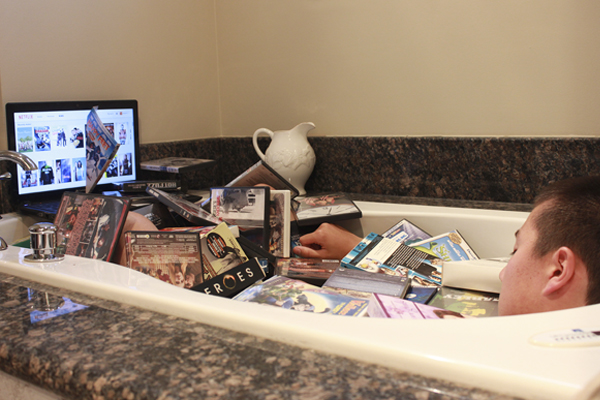How video-on-demand services leave viewers chasing the next high
Photo by Zach Verret
Netflix and other video-on-demand services enable us to experience television like never before.
They’ve made it easier, if not common practice, for people to spend entire evenings and weekends burning through seasons of their favourite TV shows. As a result, series that were originally produced over the course of years or even a decade can be consumed in a matter of weeks, or even days. It’s a glorious time for the industry.
While the full impact of our new viewing habits continues to be the subject of speculation, one thing is for sure: binge-watching is a widespread cultural phenomenon that has influenced even modest television viewers.
I know this because I once considered myself one of them. Growing up, I spent very little time in front of the “idiot box.” My parents heavily monitored my viewing time and I was largely uninterested in what TV had to offer me anyway.
But things changed when I went away to university, where I discovered the beauty of streaming websites that gave me near limitless access to the popular TV shows I had heard so much about. Before I knew it, I was watching an episode at lunch, at dinner, and a few more at night to relax. I avoided marathon-like viewing sessions, but I was nevertheless watching large quantities of television.
I’m not the only one to be seduced by the video-on-demand model. A new study conducted by the Annalect research group found that nearly two-thirds of TV viewers choose to binge-watch frequently, especially during primetime.
Binge-watching, or the mass consumption of TV shows in a single sitting, is a trend that has transformed our relationship with television, whether you’re an avid viewer or not. In many ways, the simple act of binge-watching by itself is gradually replacing the pleasure inherent in watching good television—almost like a drug habit.
We still expect quality shows, but we are far more likely to pick our next show based on its addictive quality. The enjoyment of watching the latest hit comes not from the content alone, but from the excitement of being completely and uncontrollably addicted to it.
There’s a reason why many of us let a new season of a TV show run its course on cable before fully indulging in it online. The same show, released on a weekly basis, is somehow less satisfying to watch when compared to marathon sessions on Netflix.
In turn, certain networks are already adapting to our new viewing habits. Now, several series are being constructed around the expectation that viewers will be consuming large portions of them in one sitting. Many, such as House of Cards, now have large casts and complex plotlines, yet they refrain from providing the viewer with a recap at the beginning of every episode. The reason, quite simply, is that they no longer need to, because it is expected that the last episode is still fresh in viewers minds.
Producing shows this way only serves to fuel our binge-watching habit. We are intended to watch the episodes in marathon-like bouts in order to fully appreciate them, because the narrative of one episode slides seamlessly into the next.
These days it seems like every show is worth watching. But in truth, this perception may have more to do with our addictive watching habits than the quality of the shows themselves.








